Potential use of satellite observations to detect suspended sediment in delta region: a case study of the Red river delta, Vietnam
Building an integrated river delta basin and coastal management plan in the context of climate change requires suspended sediments data, which plays an important role and is the key component for understanding the hydrology regime in the delta region. Sediments are responsible for carrying a considerable amount of nutrients and contaminants. Most sediment discharge data is acquired by surveys/ data collection activities or by mathematical modelling. However, these methods are costly, time-Consuming, and complex. Therefore, in this study, the authors investigate the potential use of satellite observations (MODIS reflectance) to detect suspended sediment flux in the Red river delta (RRD) of Vietnam. The relationships between discharge (Q), suspended sediment concentration (SSC), and total load (L) collected from the three in-situ stations Son Tay station (ST), Thuong Cat station (TC), and Hanoi station (HN) in the RRD are determined by regression analyses of reflectance data (R) obtained from MODIS bands 1-2 (250-m resolution). The results present a close connection between the monthly average of SSC and R and a good statistical relationship between the monthly average of Q and R in HN. At TC and ST, a lower correlation was found compared to HN because of the cloud cover and the position where data was collection in the river. The coefficient of determination ranged from 0.11 to 0.40 for the R-SSC and R-Q relationships. A method of estimating SSC and L at a single point along the river using data from Q and R was proposed based on the relationship correlation results
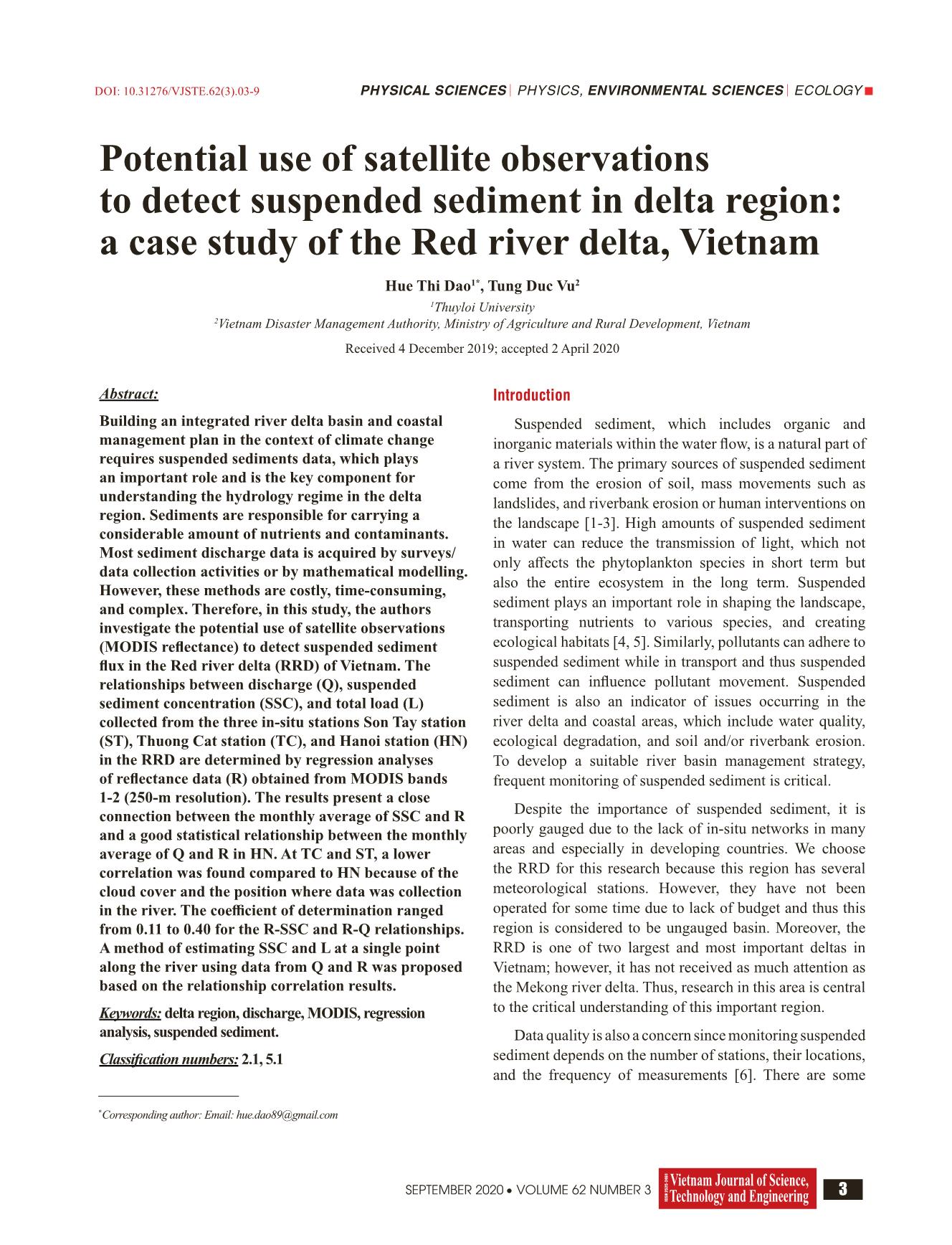
Trang 1
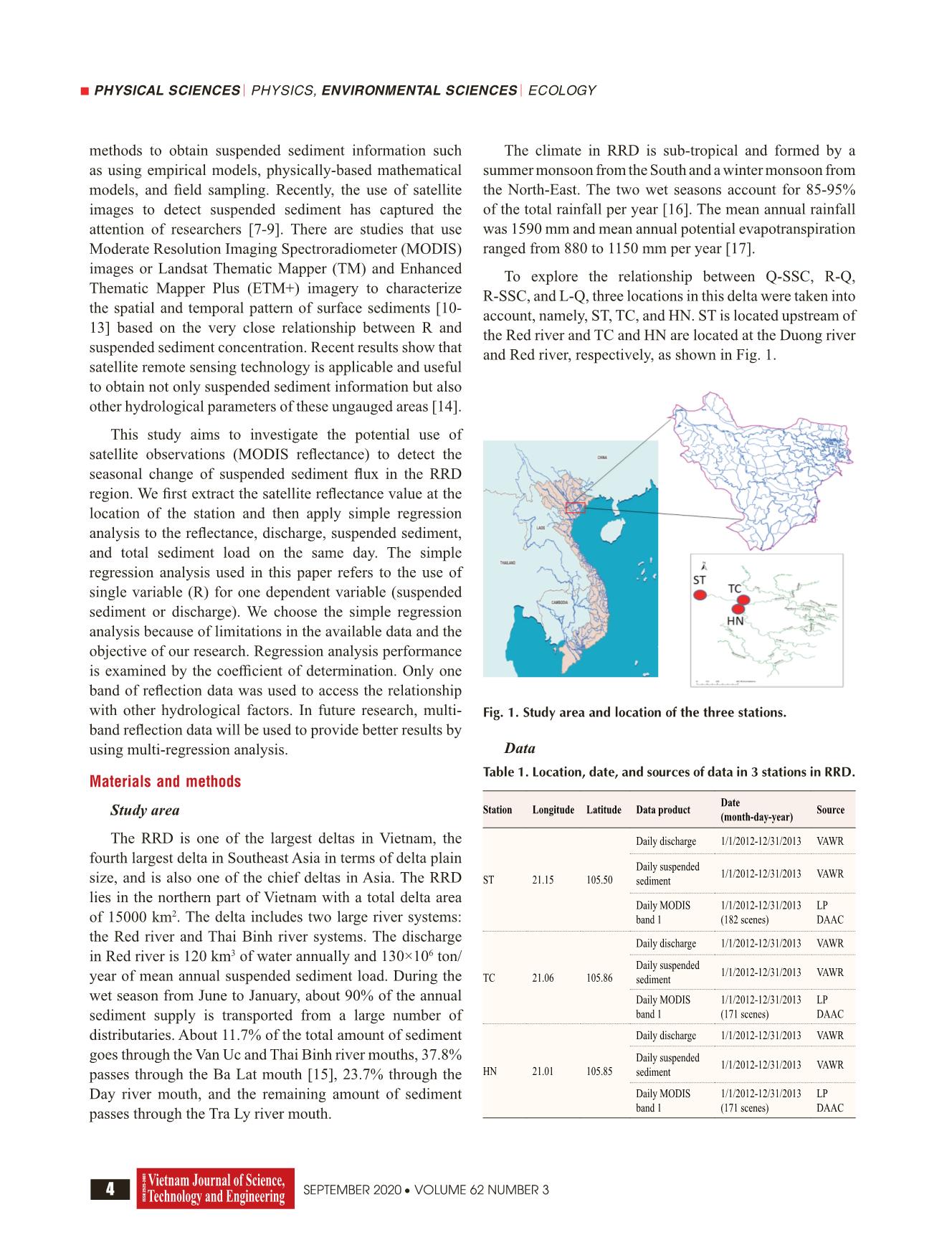
Trang 2
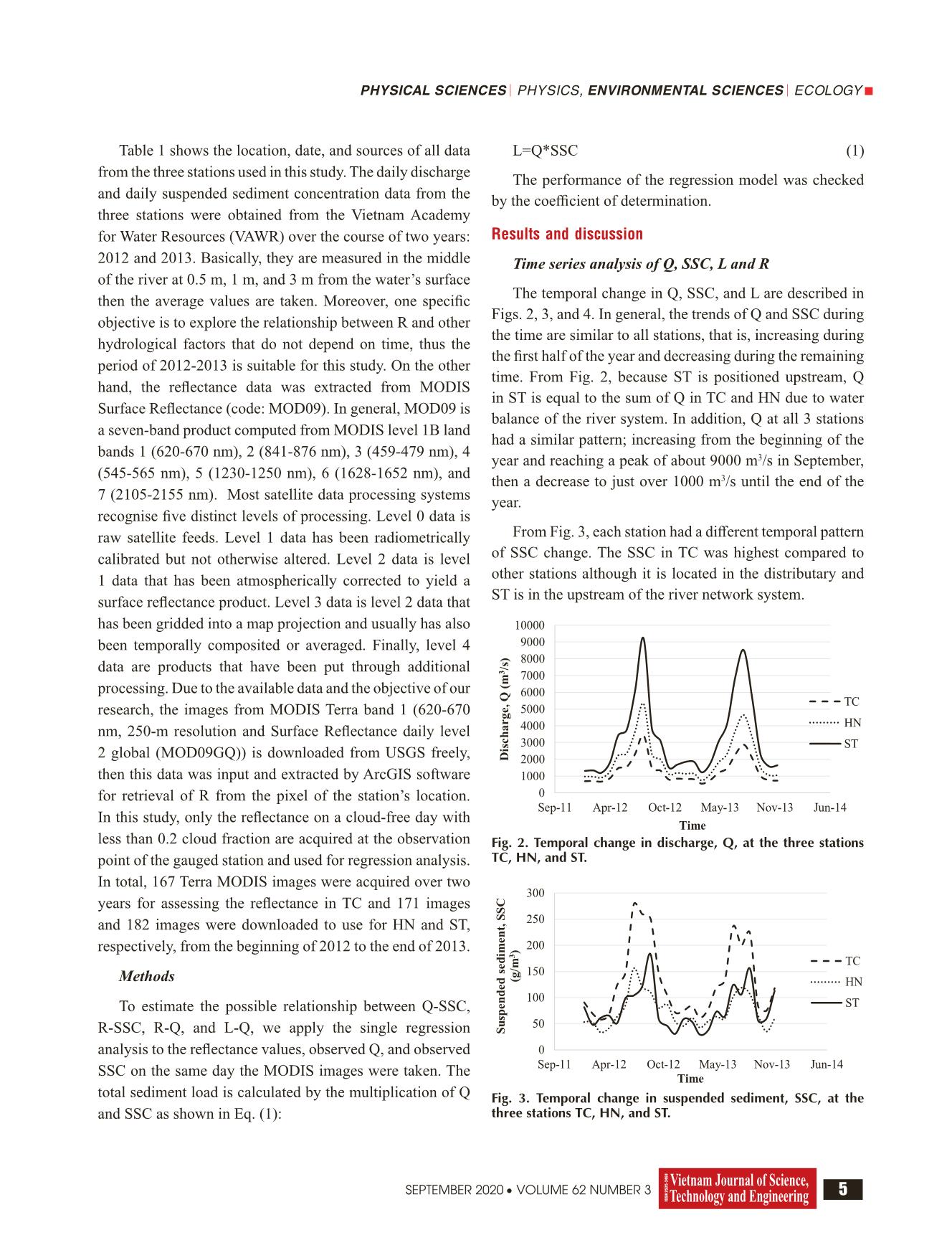
Trang 3
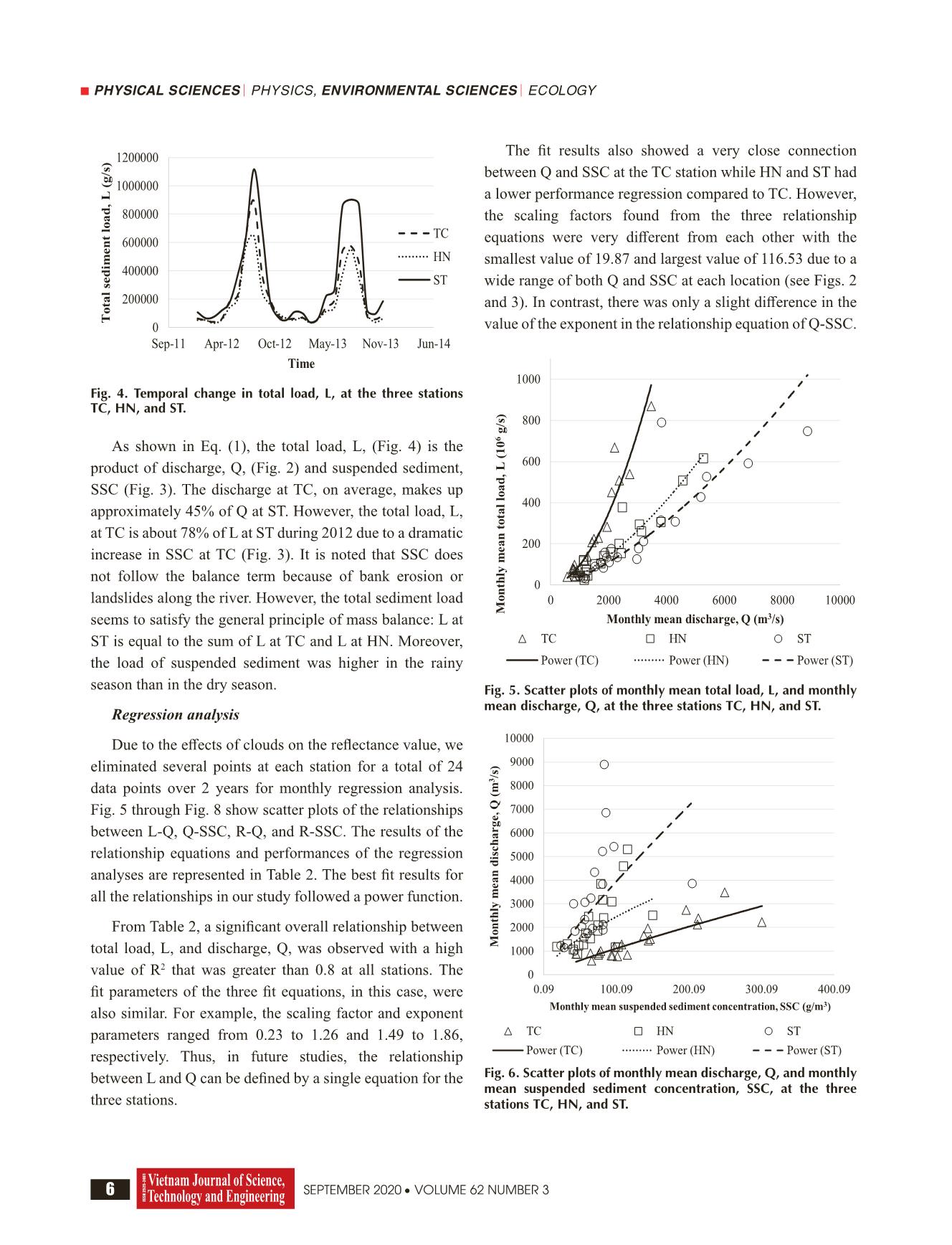
Trang 4
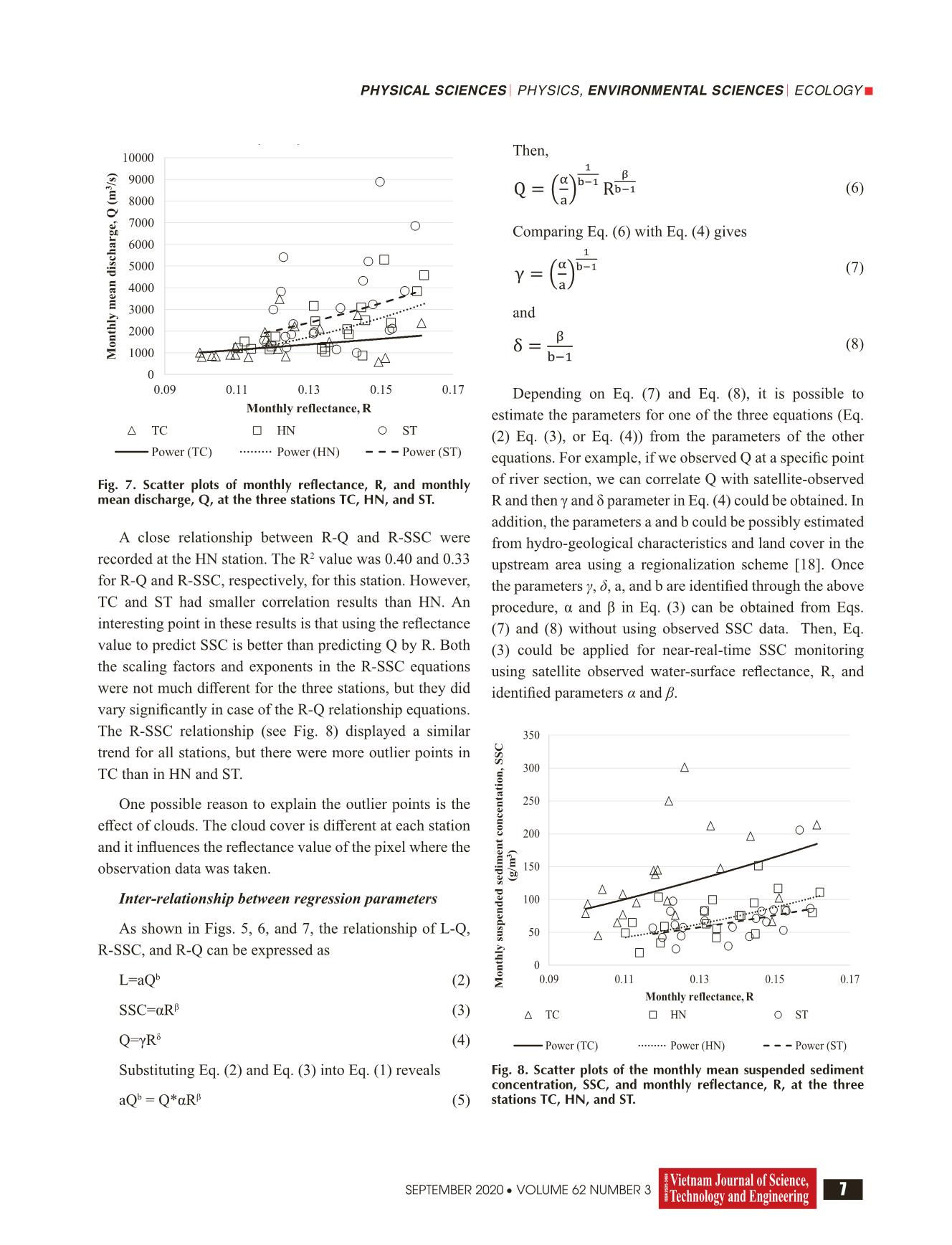
Trang 5
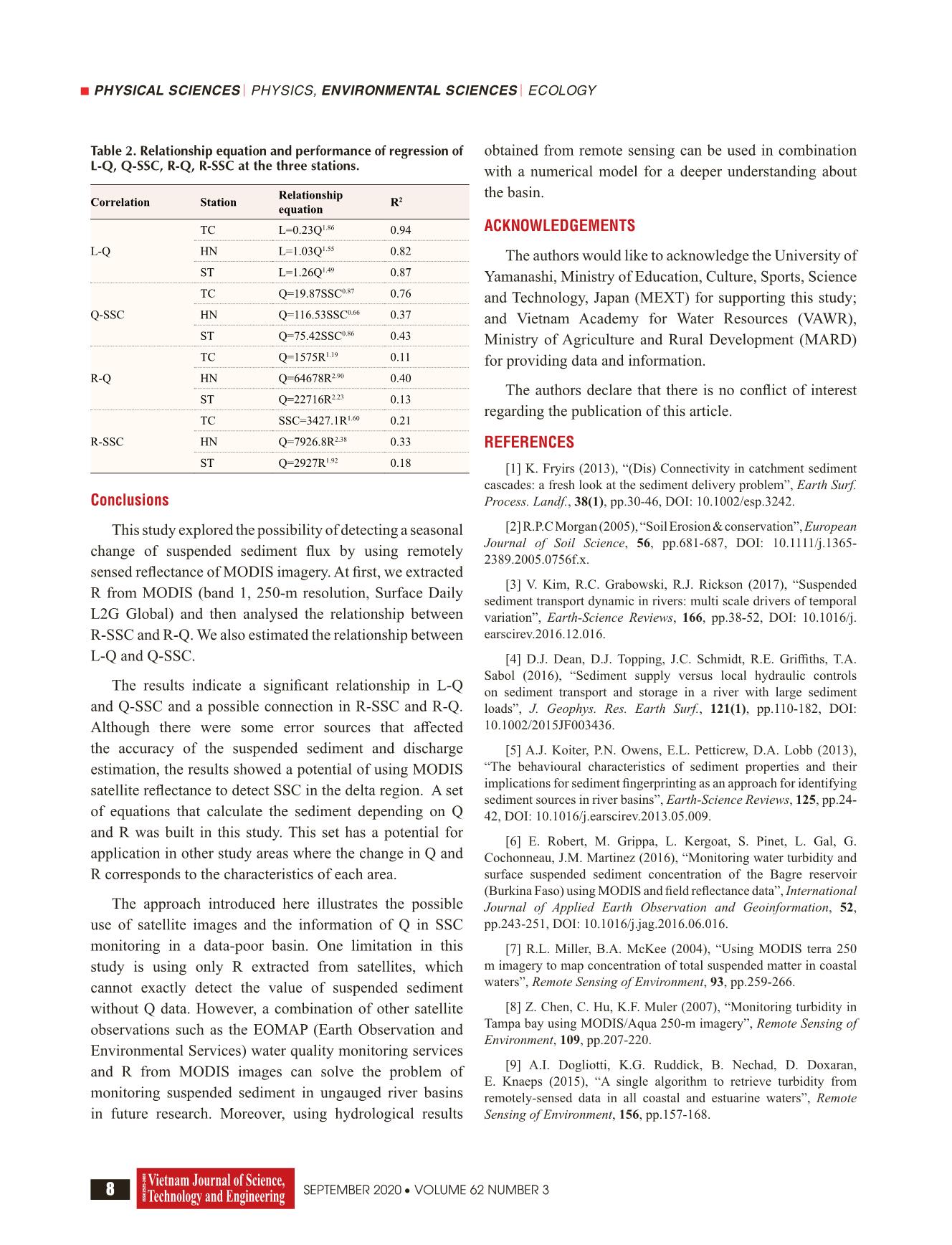
Trang 6
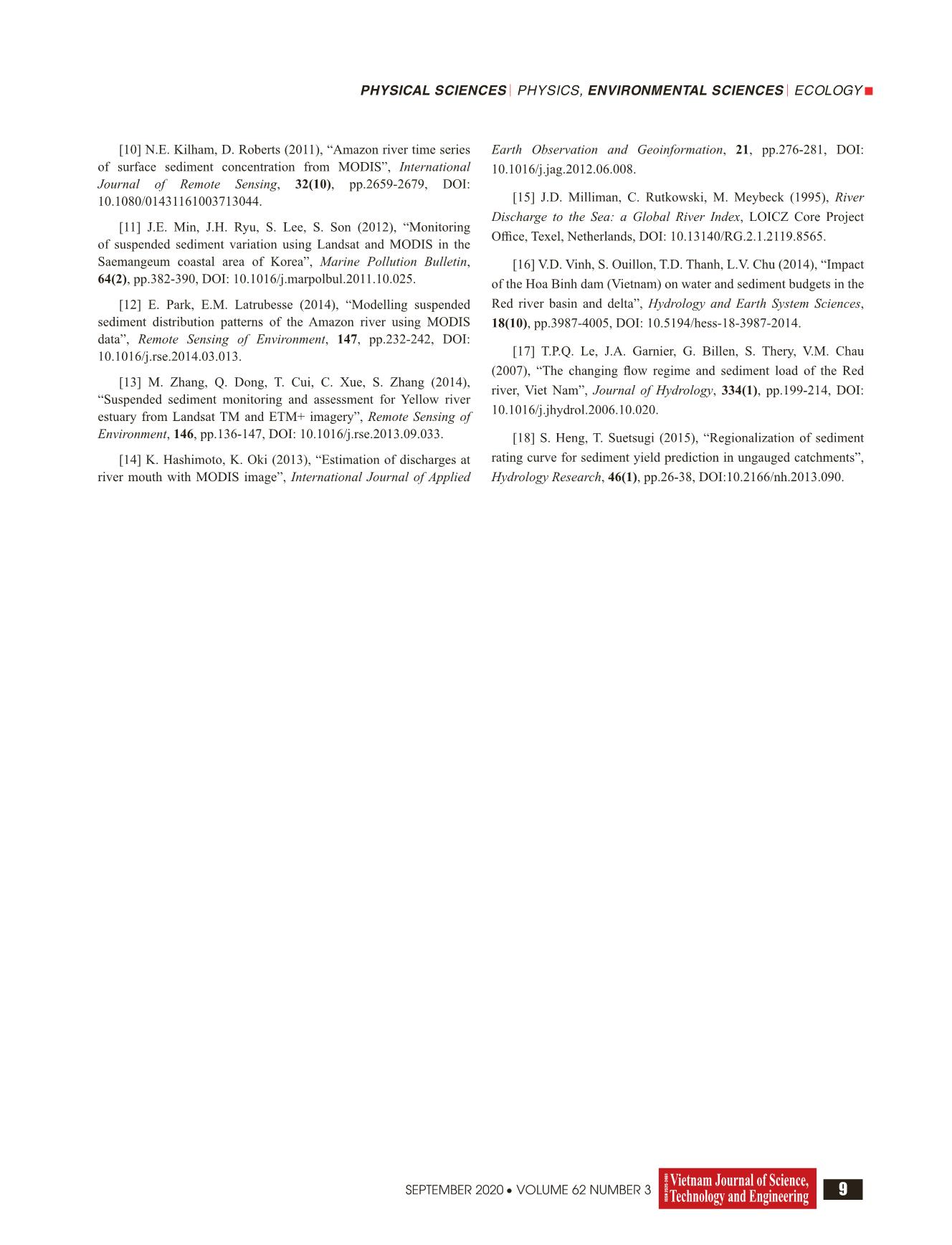
Trang 7
Tóm tắt nội dung tài liệu: Potential use of satellite observations to detect suspended sediment in delta region: a case study of the Red river delta, Vietnam
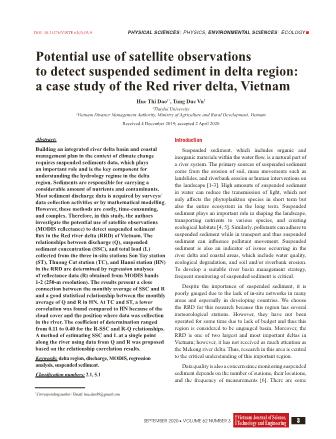
Physical sciences | Physics, environmental sciences | Ecology Vietnam Journal of Science, Technology and Engineering 3September 2020 • Volume 62 Number 3 Introduction Suspended sediment, which includes organic and inorganic materials within the water flow, is a natural part of a river system. The primary sources of suspended sediment come from the erosion of soil, mass movements such as landslides, and riverbank erosion or human interventions on the landscape [1-3]. High amounts of suspended sediment in water can reduce the transmission of light, which not only affects the phytoplankton species in short term but also the entire ecosystem in the long term. Suspended sediment plays an important role in shaping the landscape, transporting nutrients to various species, and creating ecological habitats [4, 5]. Similarly, pollutants can adhere to suspended sediment while in transport and thus suspended sediment can influence pollutant movement. Suspended sediment is also an indicator of issues occurring in the river delta and coastal areas, which include water quality, ecological degradation, and soil and/or riverbank erosion. To develop a suitable river basin management strategy, frequent monitoring of suspended sediment is critical. Despite the importance of suspended sediment, it is poorly gauged due to the lack of in-situ networks in many areas and especially in developing countries. We choose the RRD for this research because this region has several meteorological stations. However, they have not been operated for some time due to lack of budget and thus this region is considered to be ungauged basin. Moreover, the RRD is one of two largest and most important deltas in Vietnam; however, it has not received as much attention as the Mekong river delta. Thus, research in this area is central to the critical understanding of this important region. Data quality is also a concern since monitoring suspended sediment depends on the number of stations, their locations, and the frequency of measurements [6]. There are some Potential use of satellite observations to detect suspended sediment in delta region: a case study of the Red river delta, Vietnam Hue Thi Dao1*, Tung Duc Vu2 1Thuyloi University 2Vietnam Disaster Management Authority, Ministry of Agriculture and Rural Development, Vietnam Received 4 December 2019; accepted 2 April 2020 *Corresponding author: Email: hue.dao89@gmail.com Abstract: Building an integrated river delta basin and coastal management plan in the context of climate change requires suspended sediments data, which plays an important role and is the key component for understanding the hydrology regime in the delta region. Sediments are responsible for carrying a considerable amount of nutrients and contaminants. Most sediment discharge data is acquired by surveys/ data collection activities or by mathematical modelling. However, these methods are costly, time-consuming, and complex. Therefore, in this study, the authors investigate the potential use of satellite observations (MODIS reflectance) to detect suspended sediment flux in the Red river delta (RRD) of Vietnam. The relationships between discharge (Q), suspended sediment concentration (SSC), and total load (L) collected from the three in-situ stations Son Tay station (ST), Thuong Cat station (TC), and Hanoi station (HN) in the RRD are determined by regression analyses of reflectance data (R) obtained from MODIS bands 1-2 (250-m resolution). The results present a close connection between the monthly average of SSC and R and a good statistical relationship between the monthly average of Q and R in HN. At TC and ST, a lower correlation was found compared to HN because of the cloud cover and the position where data was collection in the river. The coefficient of determination ranged from 0.11 to 0.40 for the R-SSC and R-Q relationships. A method of estimating SSC and L at a single point along the river using data from Q and R was proposed based on the relationship correlation results. Keywords: delta region, discharge, MODIS, regression analysis, suspended sediment. Classification numbers: 2.1, 5.1 Doi: 10.31276/VJSTE.62(3).03-9 Physical sciences | Physics, environmental sciences | Ecology Vietnam Journal of Science, Technology and Engineering4 September 2020 • Volume 62 Number 3 methods to obtain suspended sediment information such as using empirical models, physically-based mathematical models, and field sampling. Recently, the use of satellite images to detect suspended sediment has captured the attention of researchers [7-9]. There are studies that use Moderate Resolution imaging Spectroradiometer (MoDiS) images or Landsat Thematic Mapper (TM) and Enhanced Thematic Mapper Plus (ETM+) imagery to characterize the spatial and temporal pattern of surface sediments [10- 13] based on the very close relationship between R and suspended sediment concentration. Recent results show that satellite remote sensing technology is applicable and useful to obtain not only suspended sediment information but also other hydrological parameters of these ungauged areas [14]. This study aims to investigate the potential use of satellite observations (MODIS reflectance) to detect the seasonal change of suspended sediment flux in the RRD region. We first extract the satellite reflectance value at the location of the station and then apply simple regression analysis to the reflectance, discharge, suspended sediment, and total sediment load on the same day. The simple regression analysis used in this paper refers to the use of single variable (R) for one dependent variable (suspended sediment or discharge). We choose the simple regression analysis because of limitations in the available data and the objective of our research. Regression analysis perfor ... ST had smaller correlation results than HN. An interesting point in these results is that using the reflectance value to predict SSC is better than predicting Q by R. Both the scaling factors and exponents in the R-SSC equations were not much different for the three stations, but they did vary significantly in case of the R-Q relationship equations. The R-SSC relationship (see Fig. 8) displayed a similar trend for all stations, but there were more outlier points in TC than in HN and ST. 0 1000 2000 3000 4000 5000 6000 7000 8000 9000 10000 0.09 100.09 200.09 300.09 400.09 M on th ly m ea n di sc ha rg e, Q (m 3 /s ) Monthly mean suspended sediment concentration, SSC (g/m3) TC HN ST Power (TC) Power (HN) Power (ST) 0 1000 2000 3000 4000 5000 6000 7000 8000 9000 10000 0.09 0.11 0.13 0.15 0.17 M on th ly m ea n di sc ha rg e, Q (m 3 /s ) Monthly reflectance, R TC HN ST Power (TC) Power (HN) Power (ST) Fig. 7. Scatter plots of monthly reflectance, R, and monthly mean discharge, Q, at the three stations TC, HN, and ST. A close relationship between R-Q and R-SSC were recorded at the HN station. The R2 value was 0.40 and 0.33 for R-Q and R-SSC, respectively, for this station. However, TC and ST had smaller correlation results than HN. An interesting point i these results is that using the reflectance value to predict SSC is better than predicting Q by R. Both the scaling factors and exponents in the R-SSC equations were not much different for the three stations, but they did vary significantly in case of the R-Q relationship equations. The R-SSC relationship (see Fig. 8) displayed a similar trend for all stations, but there were more outlier points in TC than in HN and ST. one possible reason to explain the outlier points is the effect of clouds. The cloud cover is different at each station and it influences the reflectance value of the pixel where the observation data was taken. Inter-relationship between regression parameters As shown in Figs. 5, 6, and 7, the relationship of L-Q, R-SSC, and R-Q can be expressed as L=aQb (2) SSC=αRβ (3) Q=γRδ (4) Substituting Eq. (2) and Eq. (3) into Eq. (1) reveals aQb = Q*αRβ (5) Then, 8 one possible reason to explain the outlier points is the effect of clouds. The cloud cover is different at each station and it influences the reflectance value of the pixel where the observation data was taken. Inter-relationship between regression parameters: As shown in Figs. 5, 6, and 7, the relationship of L-Q, R-SSC, and R-Q can be expressed as (2) (3) (4) Substituting Eq. (2) and Eq. (3) into Eq. (1) reveals aQb = Q*αRβ (5) Then, ( ) (6) Comparing Eq. (6) with Eq. (4) gives ( ) and (7) ( ) (8) Depending on Eq. (7) and Eq. (8), it is possible to estimate the parameters for one of the three equations (Eq. (2) Eq. (3), or Eq. (4)) from the parameters of the other equations. For example, if we observed Q at a specific point of river section, we can correlate Q with satellite-observed R and then γ and δ parameter in Eq. (4) could be obtained. in addition, the parameters a and b could be possibly estimated from hydro-geological characteristics and land cover in the upstream area using a regionalization scheme [18]. once the parameters γ, δ, a, and b are identified through the above procedure, α and β in Eq. (3) can be obtained from Eqs. (7) and (8) without using observed SSC data. Then, Eq. (3) could be applied for near-real-time SSC monitoring using satellite observed water-surface reflectance, R, and identified parameters α and β. (6) Comparing Eq. (6) with Eq. (4) gives 8 one possible reason to explain the outlier points is the effect of clouds. The cloud cover is different at each station and it influences the reflectance value of the pixel where the observation data was taken. Inter-relationship between regression parameters: As shown in Figs. 5, 6, and 7, the relationship of L-Q, R-SSC, and R-Q can be expressed as (2) (3) (4) Substituting Eq. (2) and Eq. (3) i to Eq. (1) reveals aQb = Q*αRβ (5) en, ( ) (6) paring Eq. (6) with Eq. (4) gives ( ) and (7) ( ) (8) Depending on Eq. (7) and Eq. (8), it is possible to estimate the parameters for one of the three equations (Eq. (2) Eq. (3), or Eq. (4)) from the parameters of the other equations. For example, if we observed Q at a specific point of river section, we can correlate Q with satellite-observed R and then γ and δ parameter in Eq. (4) could be obtained. in addition, the parameters a and b could be possibly estimated from hydro-geological characteristics and la d cover i the upstr am area using a regionalization scheme [18]. once the parameters γ, δ, a, and b are identified through the above procedure, α and β in Eq. (3) can be obtained from Eqs. (7) and (8) without using observed SSC data. Then, Eq. (3) could be applied for near-real-time SSC monitoring using satellite observed water-surface reflectance, R, and identified parameters α and β. (7) and ( ) (8) Dependi g on Eq. (7) and Eq. (8), it is p ssible to estimate the parameters for one of the three equations (Eq. (2) Eq. (3), or Eq. (4)) from the parameters of the other equation . For example, if we observed Q at a specific p int of river section, we can correlate Q with satellite-observed R and then γ and δ parameter in Eq. (4) could b obtaine . In addition, the parameters a and b could be possibly estimated rom hydro-geological characteristics and land cover in the upstream area using a regionalization scheme [18]. once the parameters γ, δ, a, and b are identified through the above procedure, α and β in Eq. (3) can be obtained from Eqs. (7) and (8) without using observed SSC data. Then, Eq. (3) could be applied for near-real-time SSC monitoring using satellite observed water-surface reflectance, R, and identified parameters α and β. 9 Fig. 8. Scatter plots of the monthly mean suspended sediment concentration, SSC, and monthly reflectance, R, at the three stations TC, HN, and ST. Table 2. Relationship equation and performance of regression of L-Q, Q-SSC, R-Q, R- SSC at the three stations. Correlation Station Relationship equation R2 L-Q TC 0.94 HN 0.82 ST 0.87 Q-SSC TC 0.76 HN 0.37 ST 0.43 R-Q TC 0.11 HN 0.40 ST 0.13 R-SSC TC 0.21 HN 0.33 ST 0.18 0 50 100 150 200 250 300 350 0.09 0.11 0.13 0.15 0.17M on th ly su sp en de d se di m en t c on ce nt at io n, S SC (g /m 3 ) Monthly reflectance, R TC HN ST Power (TC) Power (HN) Power (ST) Fig. 8. Scatter plots of the monthly mean suspended sediment concentration, SSC, and monthly reflectance, R, at the three stations TC, HN, and ST. Physical sciences | Physics, environmental sciences | Ecology Vietnam Journal of Science, Technology and Engineering8 September 2020 • Volume 62 Number 3 Table 2. Relationship equation and performance of regression of L-Q, Q-SSC, R-Q, R-SSC at the three stations. Correlation Station Relationshipequation R 2 L-Q TC L=0.23Q1.86 0.94 HN L=1.03Q1.55 0.82 ST L=1.26Q1.49 0.87 Q-SSC TC Q=19.87SSC0.87 0.76 HN Q=116.53SSC0.66 0.37 ST Q=75.42SSC0.86 0.43 R-Q TC Q=1575R1.19 0.11 HN Q=64678R2.90 0.40 ST Q=22716R2.23 0.13 R-SSC TC SSC=3427.1R1.60 0.21 HN Q=7926.8R2.38 0.33 ST Q=2927R1.92 0.18 Conclusions This study explored the possibility of detecting a seasonal change of suspended sediment flux by using remotely sensed reflectance of MODIS imagery. At first, we extracted R from MoDiS (band 1, 250-m resolution, Surface Daily L2G Global) and then analysed the relationship between R-SSC and R-Q. We also estimated the relationship between L-Q and Q-SSC. The results indicate a significant relationship in L-Q and Q-SSC and a possible connection in R-SSC and R-Q. Although there were some error sources that affected the accuracy of the suspended sediment and discharge estimation, the results showed a potential of using MoDiS satellite reflectance to detect SSC in the delta region. A set of equations that calculate the sediment depending on Q and R was built in this study. This set has a potential for application in other study areas where the change in Q and R corresponds to the characteristics of each area. The approach introduced here illustrates the possible use of satellite images and the information of Q in SSC monitoring in a data-poor basin. one limitation in this study is using only R extracted from satellites, which cannot exactly detect the value of suspended sediment without Q data. However, a combination of other satellite observations such as the EoMAP (Earth observation and Environmental Services) water quality monitoring services and R from MoDiS images can solve the problem of monitoring suspended sediment in ungauged river basins in future research. Moreover, using hydrological results obtained from remote sensing can be used in combination with a numerical model for a deeper understanding about the basin. ACKNOWLEDGEMENTS The authors would like to acknowledge the University of Yamanashi, Ministry of Education, Culture, Sports, Science and Technology, Japan (MEXT) for supporting this study; and Vietnam Academy for Water Resources (VAWR), Ministry of Agriculture and Rural Development (MARD) for providing data and information. The authors declare that there is no conflict of interest regarding the publication of this article. REFERENCES [1] K. Fryirs (2013), “(Dis) Connectivity in catchment sediment cascades: a fresh look at the sediment delivery problem”, Earth Surf. Process. Landf., 38(1), pp.30-46, Doi: 10.1002/esp.3242. [2] R.P.C Morgan (2005), “Soil Erosion & conservation”, European Journal of Soil Science, 56, pp.681-687, Doi: 10.1111/j.1365- 2389.2005.0756f.x. [3] V. Kim, R.C. Grabowski, R.J. Rickson (2017), “Suspended sediment transport dynamic in rivers: multi scale drivers of temporal variation”, Earth-Science Reviews, 166, pp.38-52, Doi: 10.1016/j. earscirev.2016.12.016. [4] D.J. Dean, D.J. Topping, J.C. Schmidt, R.E. Griffiths, T.A. Sabol (2016), “Sediment supply versus local hydraulic controls on sediment transport and storage in a river with large sediment loads”, J. Geophys. Res. Earth Surf., 121(1), pp.110-182, Doi: 10.1002/2015JF003436. [5] A.J. Koiter, P.N. owens, E.L. Petticrew, D.A. Lobb (2013), “The behavioural characteristics of sediment properties and their implications for sediment fingerprinting as an approach for identifying sediment sources in river basins”, Earth-Science Reviews, 125, pp.24- 42, Doi: 10.1016/j.earscirev.2013.05.009. [6] E. Robert, M. Grippa, L. Kergoat, S. Pinet, L. Gal, G. Cochonneau, J.M. Martinez (2016), “Monitoring water turbidity and surface suspended sediment concentration of the Bagre reservoir (Burkina Faso) using MODIS and field reflectance data”, International Journal of Applied Earth Observation and Geoinformation, 52, pp.243-251, Doi: 10.1016/j.jag.2016.06.016. [7] R.L. Miller, B.A. McKee (2004), “Using MoDiS terra 250 m imagery to map concentration of total suspended matter in coastal waters”, Remote Sensing of Environment, 93, pp.259-266. [8] Z. Chen, C. Hu, K.F. Muler (2007), “Monitoring turbidity in Tampa bay using MoDiS/Aqua 250-m imagery”, Remote Sensing of Environment, 109, pp.207-220. [9] A.i. Dogliotti, K.G. Ruddick, B. Nechad, D. Doxaran, E. Knaeps (2015), “A single algorithm to retrieve turbidity from remotely-sensed data in all coastal and estuarine waters”, Remote Sensing of Environment, 156, pp.157-168. Physical sciences | Physics, environmental sciences | Ecology Vietnam Journal of Science, Technology and Engineering 9September 2020 • Volume 62 Number 3 [10] N.E. Kilham, D. Roberts (2011), “Amazon river time series of surface sediment concentration from MoDiS”, International Journal of Remote Sensing, 32(10), pp.2659-2679, Doi: 10.1080/01431161003713044. [11] J.E. Min, J.H. Ryu, S. Lee, S. Son (2012), “Monitoring of suspended sediment variation using Landsat and MoDiS in the Saemangeum coastal area of Korea”, Marine Pollution Bulletin, 64(2), pp.382-390, Doi: 10.1016/j.marpolbul.2011.10.025. [12] E. Park, E.M. Latrubesse (2014), “Modelling suspended sediment distribution patterns of the Amazon river using MoDiS data”, Remote Sensing of Environment, 147, pp.232-242, Doi: 10.1016/j.rse.2014.03.013. [13] M. Zhang, Q. Dong, T. Cui, C. Xue, S. Zhang (2014), “Suspended sediment monitoring and assessment for Yellow river estuary from Landsat TM and ETM+ imagery”, Remote Sensing of Environment, 146, pp.136-147, Doi: 10.1016/j.rse.2013.09.033. [14] K. Hashimoto, K. oki (2013), “Estimation of discharges at river mouth with MoDiS image”, International Journal of Applied Earth Observation and Geoinformation, 21, pp.276-281, Doi: 10.1016/j.jag.2012.06.008. [15] J.D. Milliman, C. Rutkowski, M. Meybeck (1995), River Discharge to the Sea: a Global River Index, LoiCZ Core Project Office, Texel, Netherlands, DOI: 10.13140/RG.2.1.2119.8565. [16] V.D. Vinh, S. ouillon, T.D. Thanh, L.V. Chu (2014), “impact of the Hoa Binh dam (Vietnam) on water and sediment budgets in the Red river basin and delta”, Hydrology and Earth System Sciences, 18(10), pp.3987-4005, Doi: 10.5194/hess-18-3987-2014. [17] T.P.Q. Le, J.A. Garnier, G. Billen, S. Thery, V.M. Chau (2007), “The changing flow regime and sediment load of the Red river, Viet Nam”, Journal of Hydrology, 334(1), pp.199-214, Doi: 10.1016/j.jhydrol.2006.10.020. [18] S. Heng, T. Suetsugi (2015), “Regionalization of sediment rating curve for sediment yield prediction in ungauged catchments”, Hydrology Research, 46(1), pp.26-38, Doi:10.2166/nh.2013.090.
File đính kèm:
 potential_use_of_satellite_observations_to_detect_suspended.pdf
potential_use_of_satellite_observations_to_detect_suspended.pdf

